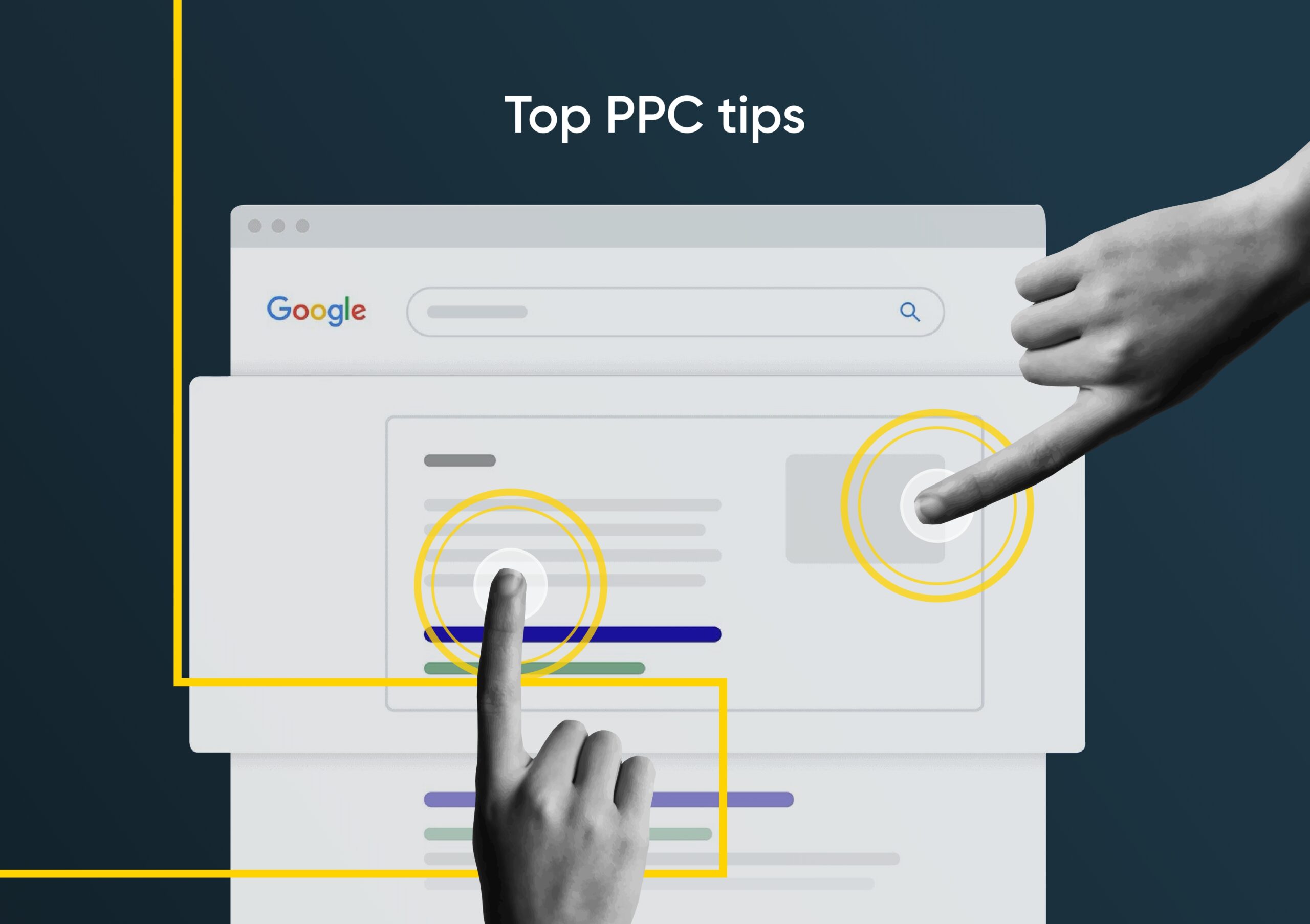Average Google Ad return on ad spend (ROAS) sits at around 2:1.
So for every £1 you invest in Google Ads, you should see £2 returned, if performing as expected.
However, why settle for 2:1? Many successful PPC (pay per click) campaigns see returns significantly higher, even around the 8:1 mark or higher!
While this may be a little ambitious, especially if you’re just starting out, a good ROAS to strive for sits at about 4:1. This will vary by industry, but it’s a decent benchmark to get you started. Even modest budgets can see healthy PPC leads and returns in their first year (which we usually recommend reinvesting into your PPC until returns start to diminish).
So, to help you see better results out of your Google PPC Ads, here are 6 tips to get the best out of your search & display PPC ads.
1. Set your tracking up correctly
Without well-optimised tracking, you’ll never see great PPC leads from your Google PPC Ads. You need data, otherwise you’re just taking shots in the dark.
This is, without a doubt, the most important thing to get right. Here’s how to properly set up your tracking:
Create a Google Ads account
If you haven’t already, sign up for a Google Ads account at ads.google.com.
Install Google Analytics (optional, but recommended)
Google Analytics helps you track user behaviour on your website. If you’re using Google Analytics, link it to your Google Ads account for more comprehensive tracking.
Set up conversion tracking
Conversion tracking allows you to measure the actions that users take after clicking on your ads. To set up conversion tracking:
- In your Google Ads account, go to “Tools & Settings” > “Measurement” > “Conversions.”
- Click on the blue plus button to create a new conversion action.
- Choose the appropriate conversion source: Website, App, or Phone calls.
- Follow the prompts to configure your conversion tracking based on your goals. You can track actions like purchases, form submissions, sign-ups, etc.
- Install the conversion tracking tag on your website. This involves adding a small snippet of code to the page that users reach after completing the desired action.
Set up conversion import (if applicable)
If your conversions happen offline or on a different platform (such as a CRM system), you can import these conversions into Google Ads. To set up conversion import:
- In your Google Ads account, go to “Tools & Settings” > “Measurement” > “Conversions.”
- Click on the blue plus button to create a new conversion action.
- Choose the appropriate conversion source: Import.
Enable auto-tagging
Auto-tagging automatically adds tracking parameters to your ad URLs, allowing Google Ads to track clicks accurately. To enable auto-tagging:
- In your Google Ads account, go to “Settings” > “Account settings.”
- Scroll down to the “Tracking” section and make sure that “Auto-tagging” is enabled.
Use UTM parameters (Optional)
If you’re running ads outside of Google Ads (e.g., on social media platforms), use UTM parameters to track their performance in Google Analytics.
UTM parameters are tags attached to your URLs, providing additional information about the source of your traffic. You can use Google’s Campaign URL Builder tool to generate UTM links.
Test your tracking setup
Once you’ve implemented tracking, it’s crucial to test it to ensure that it’s working correctly. Click on your ads, complete conversion actions, and verify that the data is being recorded accurately in Google Ads and Google Analytics.
Monitor and Optimise
Continuously monitor your tracking data to evaluate the performance of your ads. Use the insights gained to optimise your campaigns, such as adjusting bidding strategies, targeting settings, ad creatives, etc.
The above steps can be a little overwhelming, especially if you’re just starting out. If you need any advice on setting up your Google PPC Ads tracking, or would like some support running successful ad campaigns, don’t hesitate to get in touch with our pay per click marketing agency today.
2. Perform thorough keyword research
Keywords are the fuel of any successful PPC campaign.
More often than not, you’ll be surprised at what your target audience are actually searching for. You can use tools such as SEMrush, MOZ or Ahrefs to identify the keywords that will prove fruitful for you, as well as find ‘red herring’ words – words or phrases that you think would be relevant, but ultimately aren’t going to deliver results.
Remember: keyword research is an ongoing thing. If you want to see Google PPC Ad success, you’ll need to regularly reevaluate your keywords. Take a look at your Google Analytics to see which ads are performing well, and which ones are falling short.
It makes sense to prioritise your budget on the phrases that are delivering, but always allocate some budget for experimentation (sometimes, a very specific ad will surprise you, pressing all the right buttons and delivering some serious PPC leads!). You should break your keywords down into two categories:
Short-tail keywords
Short-tail keywords are broad and relatively generic. They should (obviously) be relevant to your industry, but will often have a high search volume (which usually means high levels of competition).
Examples of short-tail keywords might be “marketing”, “shoes”, or “pasta”. Important to include (especially if you’re working at a cobbler that specialises in marketing Italian food), but you’re unlikely to see fantastic returns from these (although they can be good to help expose your brand to a wider audience).
Where you really start to see results is with your long-tail keywords.
Long-tail keywords
Long-tail keywords are search queries that get significantly lower volume, but often have much more intent behind them.
For example, “Digital marketing services in Birmingham”, “Buy size 11 Air Jordans UK”, or “Best linguine near me”.
If your PPC ads are targeting these more niche long-tail keywords, then they’re more likely to be seen by people who are ready and raring to convert.
As a result, you should always identify the keywords that balance search volume, keyword difficulty and search intent. Get this right and you’ll drive the right traffic to the right pages at the right time. This is the secret to creating Google PPC Ads that convert into warm PPC leads.
3. A/B test your campaigns (experiment with new ad copy)
A/B testing is essential in most areas of marketing, but especially when running Google PPC Ads.
Here’s a quote from another blog of ours that explains what A/B testing is:
“A/B testing is a well-established user experience research methodology.
In short, you alter two variables and measure the difference this makes. It’s incredibly important that every other variable remains the same – the only things that change are your ‘A’ and ‘B’.
This allows you to measure whether there’s any difference made by changing certain aspects of your marketing campaign.”
So, in PPC terms, say you’ve been running an ad for a few weeks. You’ve got data that shows it’s performing relatively well, but you’d like to know whether it could perform better with slightly altered ad copy.
You change the ad copy slightly (leaving everything else the same), and let the ad run for a few more weeks. After this period, you can now compare your two ads, your ‘A’ and ‘B’ to see which your target audience resonated with the most.
Use these insights to inform your future ads, and continue to test variables as you go. Your PPC should continue to evolve alongside your business; A/B testing is essential in making this evolution happen.
4. Create unique landing pages
Your landing pages are really, really important.
Why spend £1000s on Google PPC Ads if you’re going to direct clicks to a generic landing page that’s poorly optimised and isn’t ready to deliver results? Studies show that good landing page optimisation can improve your CTR (click-through rate) by anywhere from 15-30%, meaning that 15-30% more PPC leads will get in touch/take your desired action!
If you’re going to do it, we highly recommend doing it properly, which means:
Relevant, fast and functional landing pages
As soon as a prospect lands on your page, what are they seeing? Does it match the ad they’ve just clicked on?
There should be relevant, enticing copy at the top of the page (not too much). This should be accompanied by a form that collects only essential data. The more data you ask for, the less likely the prospect will fill out your form. Make sure you get their email address/contact information – this is more important than anything else, as once you’ve captured their data, you can follow up with further marketing and nurturing content.
Your landing page designs should be aesthetically pleasing, but uncluttered. Consider the user experience of the page; show it to others and get their feedback on how easy the page is to use.
Ask yourself:
- Is my landing page relevant to my ad?
- Does the page load fast?
- Does the page load correctly on different devices, like smartphones and tablets?
- Is the page easy to use and navigate?
- Does the page copy expand on the ad copy?
If you’re answering ‘yes’, then you’re good to go! Again, make sure to source a second opinion on these questions.
5. Keep your ad account(s) organised
Everyone, even seasoned PPC experts, will find their Google PPC Ads account(s) becoming disorganised at times.
It’s incredibly easy for your account to get a little messy.
We highly recommend creating an audit schedule – time for you to comb through your ads account, deleting unnecessary or outdated campaigns, refining your ad groups and reevaluating your keywords.
You may even choose to separate your PPC efforts into different accounts (this might be important if your business has a broad range of services/products).
6. Get a PPC audit
PPC is difficult to get right. It takes time, effort and investment – don’t be disheartened if your initial attempts deliver less PPC leads than you’d hoped, that’s perfectly normal.
As time goes on, you’ll gather more data, you’ll learn what works (and what doesn’t), and you’ll start to see the results you wanted.
However, if time is not on your side, there is a shortcut – get a PPC audit conducted by a pay per click marketing agency.
Fortunately, you’re already on a website, reading a blog written by a PPC specialist – how fortuitous!
Click the link below to book your free PPC audit. We work with clients of all shapes and sizes from across the UK, helping them drive more, better PPC leads than ever before.
Looking for a little more reading? Why not learn a bit more about Catalyst, and why businesses love partnering with us?
Why businesses love partnering with Catalyst

